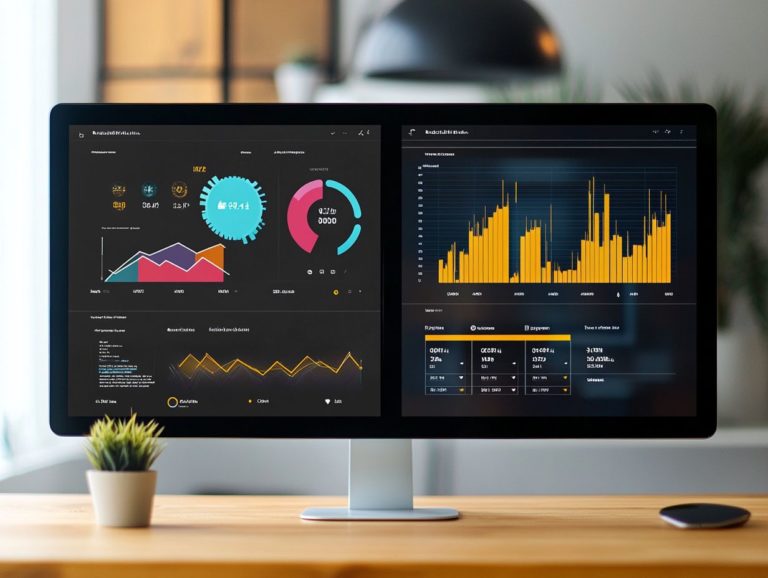Understanding the Psychology of Pricing
Pricing transcends mere numbers; it’s a complex relationship between psychology and consumer behavior.
This article delves into how perceptions and emotions influence your pricing decisions, illuminating the essential reasons why pricing is significant in today s competitive marketplace.
Get ready to explore the many factors that shape pricing, from consumer behavior and competition to strategic approaches like cost-plus and psychological pricing, which are strategies that use psychological insights to influence pricing.
The discussion also covers the ethical considerations surrounding pricing practices, ensuring that businesses strike a balance between fairness and profitability.
Jump in to discover exciting insights about the role of psychology in crafting pricing strategies that truly resonate with consumers.
Contents
- Key Takeaways:
- The Role of Psychology in Pricing
- Factors that Influence Pricing
- Common Pricing Strategies
- Applying Psychology in Pricing
- The Ethics of Pricing
- Frequently Asked Questions
- What is the psychology behind pricing?
- Why is understanding the psychology of pricing important for businesses?
- What are the key principles of pricing psychology?
- How do emotions play a role in pricing decisions?
- What are some common pricing strategies based on psychology?
- How can businesses use psychological pricing to increase sales?
Key Takeaways:

The Role of Psychology in Pricing
The complex relationship between psychological pricing and consumer behavior profoundly influences customer loyalty and market dynamics. By leveraging strategies such as charm pricing and price bundling, you can enhance perceived value and effectively shape the decision-making process of your consumers.
It s essential to consider how various pricing techniques, like decoy pricing where a less attractive option is presented to make other options appear more appealing and price anchoring, can create artificial time constraints that effectively drive consumption.
Grasping these psychological factors is crucial for optimizing renewal rates in subscription models and securing long-term profitability.
Why Pricing Matters
Pricing holds considerable significance as it directly shapes perceived value, customer satisfaction, and renewal rates across various industries, including eCommerce and subscription services.
In eCommerce, you might notice that lower prices can lead consumers to suspect quality compromises, making them wary of bargain deals.
On the other hand, subscription services that implement tiered pricing can enhance perceptions of value, motivating you to choose higher-priced plans for added benefits like premium content or exclusive features.
Take streaming platforms, for example. They often entice new subscribers with introductory pricing before gradually increasing rates. If you find genuine value in the content offered, this strategy can foster loyalty.
By adopting this thoughtful approach, businesses can build enduring relationships with their customers, ultimately resulting in increased sales and improved retention.
Factors that Influence Pricing
Several factors influence your pricing strategy, including psychological pricing techniques, the competitive landscape, and prevailing market trends.
Each of these elements plays a crucial role in shaping your approach to consumption matters, helping you make informed decisions that resonate with your target audience.
Consumer Behavior and Perceived Value
Consumer behavior is intricately tied to perceived value. Techniques like charm pricing can provide that crucial attention boost that dramatically shifts buying behavior.
By tapping into how customers interpret price points, you can align your offerings more closely with what consumers expect.
Research indicates that products priced just below a whole number often appear significantly cheaper, prompting potential buyers to make those impulsive decisions.
Take a leading airline, for example: they discovered that minor tweaks in ticket pricing not only boosted sales but also enhanced customer satisfaction.
By understanding these psychological triggers, you can develop more effective pricing strategies, ultimately paving the way for greater profitability and customer loyalty.
Competition and Market Trends

Competition and market trends are crucial in shaping effective pricing strategies, influencing how prices are perceived and how consumers respond.
In a landscape marked by rapid technological advancements and evolving consumer preferences, stay agile and adapt quickly! Understanding these trends empowers you to craft pricing models that resonate with your target audience and anticipate your competitors’ next moves.
To stay ahead, leverage data analytics to uncover valuable consumer insights. This enables you to fine-tune your offerings. Using psychological pricing techniques can elevate the perceived value of your products without sacrificing profit margins.
Strategies like dynamic pricing (adjusting prices based on demand), loyalty programs, and promotional campaigns can further engage your consumers while ensuring you strike the perfect balance between affordability and quality.
Common Pricing Strategies
Common pricing strategies such as cost-plus pricing, value-based pricing, and psychological pricing are essential tools for enhancing sales strategies and optimizing profitability.
By understanding and effectively implementing these approaches, you can elevate your business’s financial performance and ensure sustainable growth. It s crucial to implement these strategies now to stay competitive.
Cost-Plus Pricing
Cost-plus pricing is a straightforward strategy where you calculate your costs and then add a markup to determine the final price. This ensures long-term profitability.
This method provides a clear framework for setting prices, which is particularly helpful in industries with stable cost structures, like manufacturing and retail. For example, if you’re a furniture maker, assess the costs of raw materials, labor, and overhead. Then apply a consistent percentage increase to determine your selling price.
This approach simplifies your pricing strategy and helps mitigate risks associated with fluctuating costs.
However, be mindful of potential pitfalls. If you overlook market conditions or consumer perceptions, you might unintentionally price yourself out of the competitive landscape. In the tech sector, where innovation drives rapid change, relying solely on cost-plus pricing could lead to obsolescence unless you also consider value-based pricing.
Value-Based Pricing
Value-based pricing centers on the perceived value of a product or service to you, the consumer, rather than just the costs incurred by the company. This transforms pricing into a powerful strategy for enhancing your satisfaction.
By emphasizing what you believe a product is genuinely worth instead of merely applying a markup to production costs, businesses can develop pricing strategies that truly resonate with you and others in their target audience.
This method requires a deep understanding of your needs, preferences, and the unique benefits a service provides, ultimately leading to greater loyalty and repeat business.
Consider companies like Apple and Tesla; they embody the success of value-based pricing by positioning their products as premium offerings, celebrated for their innovation and quality. These examples demonstrate that when you feel you’re receiving exceptional value, you re often willing to pay a premium, allowing organizations to flourish in competitive markets.
Psychological Pricing
Psychological pricing employs a range of techniques, such as charm pricing and price anchoring, to subtly influence your buying behavior, making products more alluring.
By setting prices just below a round number like pricing an item at $9.99 instead of $10.00 marketers tap into your perception of value, effectively stimulating your desire to purchase. Research indicates that retail powerhouses like Walmart and Target have mastered these strategies, leading to notable increases in both sales and customer satisfaction.
Another fascinating approach is price anchoring, where an initial high price serves as a reference point. This allows subsequent lower prices to appear as irresistible deals. This tactic shines in furniture retail, particularly at places like IKEA, where you’re more likely to see a discounted sofa as a steal when it’s showcased next to a pricier option.
Take a moment to evaluate your current pricing strategies or learn more about these topics to enhance your business’s success!
Applying Psychology in Pricing

Applying psychology to pricing means using techniques such as anchoring and framing to influence perceived value. This, in turn, shapes the consumer’s decision-making process, which is the way they evaluate options.
Understanding how these strategies work allows you to effectively guide potential buyers toward making choices that align with your pricing objectives.
Using Anchoring and Framing Techniques
Anchoring and framing techniques are vital components of using psychology in pricing. They expertly shape perceptions and influence decision-making.
By presenting information strategically, brands can guide you toward specific choices. Consider a luxury watch brand that displays an original price of $5,000 next to a discounted price of $3,500. This approach effectively sets a reference point, making the discount feel more enticing.
In addition, a well-known coffee chain emphasizes the ‘value’ of a larger size while subtly downplaying smaller options. This tactic makes you feel like you’re making a smarter, more economical choice.
These strategies highlight how the presentation of information can significantly impact consumer behavior, ultimately driving sales and cultivating brand loyalty.
Utilizing the Power of Perception
Utilizing the power of perception is essential in your pricing strategies. It significantly impacts perceived value and can give you an attention boost that enhances customer satisfaction.
Take charm pricing, for example where you set your prices just below a round number, like $9.99 instead of $10.00. This minor adjustment elevates a consumer’s perception of value, making your product appear more affordable and enticing.
Consider Apple, which masterfully positions its products as premium offerings. This strategy creates an aura of exclusivity that draws in a loyal customer base, eager to invest more for that perceived luxury.
By understanding and adeptly manipulating perception, you can boost customer satisfaction while driving sales. Leveraging simple psychological principles can work to your advantage.
The Ethics of Pricing
Pricing ethics involves embracing fair and transparent practices that nurture customer loyalty. By steering clear of manipulative tactics, you can build and maintain trust. This creates a solid foundation for long-lasting relationships with your customers.
Fair and Transparent Pricing Practices
Fair and transparent pricing practices are crucial for building customer loyalty and cultivating a positive brand image in today s competitive landscape. When you prioritize honesty in your pricing strategies, you enhance customer trust and encourage an open dialogue between your brand and its consumers.
Consider organizations like Buffer and Warby Parker. They openly share their pricing structures and the reasons behind their costs, allowing you to see the value you are receiving. This transparency paves the way for lasting relationships.
By demystifying pricing, these companies alleviate the anxiety that often accompanies purchasing decisions. This fosters mutual respect and understanding that ultimately benefits you and your customers.
Act now to capitalize on these strategies!
Avoiding Manipulative Tactics

Avoiding manipulative pricing tactics is essential for maintaining customer trust and ensuring your long-term success through ethical pricing strategies.
When you resort to misleading discounts or hidden fees, you may see a temporary profit spike, but this approach ultimately erodes the trust you’ve built with your clientele. Tactics like bait-and-switch schemes or artificially inflated prices undermine the very foundations of transparency and integrity.
Customers will become wary, leading to diminished loyalty and increased scrutiny of your business practices.
By prioritizing honest communication through sustainable strategies, you can foster a healthier relationship with your consumers, encouraging repeat business that’s vital for longevity. Embracing ethical pricing not only enhances your company’s reputation but also cultivates a more reliable and satisfied customer base.
Frequently Asked Questions
What is the psychology behind pricing?
The psychology of pricing is the study of how consumers perceive and respond to different price points. It examines the various factors that influence a consumer’s decision to make a purchase, such as their emotions, motivations, and rational thinking.
Why is understanding the psychology of pricing important for businesses?
Understanding the psychology of pricing is important for businesses because it can help them determine the most effective pricing strategies to increase sales and profit. By understanding how consumers think and behave, businesses can set prices that appeal to their target market and encourage them to make a purchase.
What are the key principles of pricing psychology?
The key principles of pricing psychology include anchoring, the decoy effect, price relativity, loss aversion, and the power of free. Anchoring refers to the tendency for consumers to rely heavily on the first price they see. The decoy effect occurs when a third, less desirable option is presented to make the other options seem more attractive. Price relativity is the idea that consumers compare prices to other similar products or services. Loss aversion is the tendency for consumers to avoid losses more than they seek gains. The power of free is the ability of a free offer to significantly influence a consumer’s decision to make a purchase.
How do emotions play a role in pricing decisions?
Emotions play a significant role in pricing decisions because they can influence a consumer’s perception of value. For example, if a consumer feels a product or service is too expensive, they may decide not to purchase it, even if it is objectively priced the same as a similar product. On the other hand, if a consumer feels a product is a good deal or a bargain, they are more likely to make a purchase, even if it is priced higher than other similar products.
What are some common pricing strategies based on psychology?
Some common pricing strategies based on psychology include charm pricing (ending prices with 9 or 99), bundle pricing (combining products at a lower overall price), and prestige pricing (setting a higher price to create a perception of luxury or quality). Other strategies include price anchoring (setting a higher price initially to make a lower price seem more reasonable), price-matching (matching a competitor’s price to stay competitive), and dynamic pricing (adjusting prices based on demand and other factors).
How can businesses use psychological pricing to increase sales?
Businesses can use psychological pricing to increase sales by understanding their target market and tailoring their pricing strategies accordingly. This may include using charm pricing to make prices seem lower, offering free gifts or samples to create a sense of reciprocity, and highlighting the value and benefits of a product to justify a higher price. Additionally, businesses can use pricing psychology to upsell and cross-sell products, as well as create a sense of urgency through limited-time offers or discounts.






